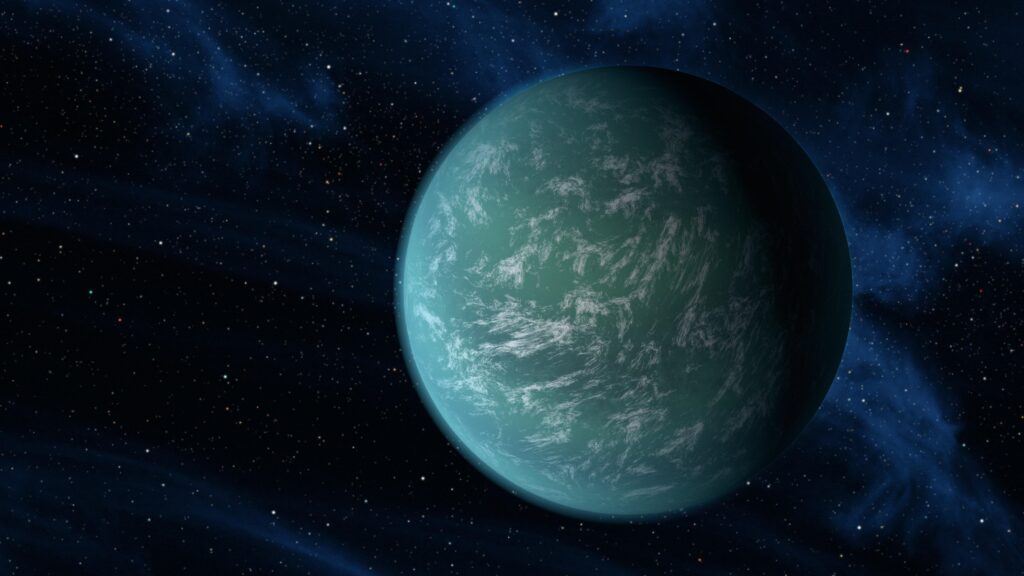Any potential alien life in the waters of vast ocean worlds could receive vital nutrients from their planets’ molten cores via thick layers of exotic high-pressure ice that can transport salts, new research has found. Water is one of the most common molecules in the universe, and worlds covered by global oceans hundreds of miles deep may vastly outnumber “drier” planets like Earth . Examples of such water worlds include several of the planets in the TRAPPIST-1 system, as well as GJ 1214b, Kepler-62e and Kepler-62f .
Conditions at the bottom of these oceans are so extreme that water is compacted enough to form a high-pressure ice known as ice VII. The molecules of ice VII are arranged in a cubic crystalline structure, and it exists at pressures greater than 3 gigapascals (approximately 29,000 atmospheres) and temperatures up to 662 degrees Fahrenheit (350 degrees Celsius). Related: Ultrahot ‘superionic’ ice is a new state of matter However, scientists were uncertain about whether salts and other nutrients could move from a planet’s rocky core, through the ice VII mantle and into the liquid ocean — and back down again.
Normal ice expels salt when it freezes, but new modeling shows that ice VII can retain salt crystals. In particular, the research showed that ice VII can contain up to 2. 5 wt% (weight percentage) of sodium chloride, more commonly known as table salt.
The presence of salt lowers the melting point of the ice, softening it and thus helping thermal convection currents cause the salty ice to rise. “The transport of salt would not only be from the bottom to the top, but also from the top to the bottom,” said Jean-Alexis Hernandez, a scientist at the European Synchrotron Radiation Facility in France who led the new work. “Hot ice at the bottom of the mantle becomes gravitationally unstable because, being hotter, it is less dense than the surrounding ice, which makes it rise.
A global flow develops and is maintained by the temperature difference between the top and the bottom of the mantle,” Hernandez told Space. com. This flow recycles the nutrients and salts necessary for biochemistry.
While their presence does not guarantee that life exists in the oceans of these water worlds, it does increase the chances that such worlds could be habitable. “The findings increase the number of planetary candidates for habitability by including super-Earths with high-pressure ice mantles,” Baptiste Journaux, an instructor in the Department of Earth and Space Sciences at the University of Washington in Seattle, told Space. com.
Journaux was not involved in the research but wrote a commentary on the new research for the journal Nature Communications. The results may also bring fresh insights much closer to home. The closest analogues to ocean worlds in our solar system are some of the frozen moons of Jupiter and Saturn .
Although many of the moons are too small to harbor high-pressure ice, the largest of them — Jupiter’s Callisto and Ganymede, and Saturn’s Titan — are massive enough to create a mantle of ice VI, which forms at 1 GPa (approximately 10,000 atmospheres). Although ice VI is insoluble, researchers have previously detected hydrated salt minerals that have stained the surfaces of some of these moons, presumably from upwelling from the oceans below their icy surfaces. Scientists believe that this finding indicates that some salt transport must be taking place.
In the Jupiter system, some of these moons also have an induced magnetic field originating from interactions between their electrically conducting salty subsurface oceans and the planet’s immense magnetic field. “Salts still play an important role in these objects as they modify phase boundaries [i. e.
, the transition regions between rock, ice and liquid] and the properties of water, which strongly influences the dynamics of the ice shell and oceans on these icy moons,” Hernandez said. Callisto, Ganymede and Titan are, therefore, currently the best places for testing our geophysical models describing the permeability of high-pressure ices, Journaux told Space. com.
In particular, scientists will soon have a wealth of new data from the European Space Agency’s Jupiter Icy Moons Explorer (JUICE) mission, which will launch in 2023. JUICE will be supported by NASA’s Europa Clipper mission, which will launch in 2024 and visit Ganymede and Callisto as well as Europa, and by NASA’s Dragonfly helicopter mission to Titan, which will launch in 2027. — The ocean on Jupiter’s moon Europa has table salt, just like Earth’s seas — Alien-life hunters are eyeing icy ocean moons Europa and Enceladus — Could alien life cling beneath the icy ceilings of frigid ocean moons? “The data that we’ll get on the icy moons will greatly help our understanding of the role of high-pressure ice mantles in controlling the composition and habitability of extraterrestrial oceans,” Journaux said.
The same studies, however, cannot currently be made for distant exoplanets. So, for now, determining whether ocean worlds could be habitable will remain mostly a matter for modeling rather than observation. The research was published June 21 in the journal Nature Communications (opens in new tab) .
Follow Keith Cooper on Twitter @21stCenturySETI. Follow us on Twitter @Spacedotcom and on Facebook . .
From: space
URL: https://www.space.com/alien-ocean-worlds-exotic-ice-transfer-nutrients/
